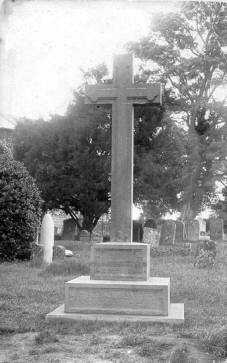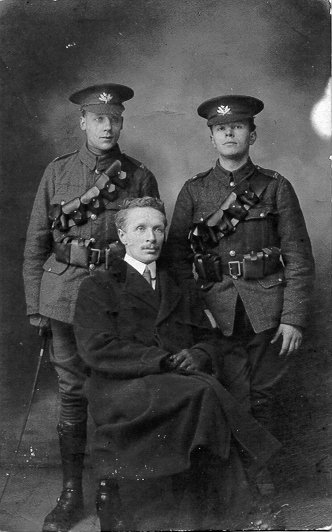
The War Memorial: "Their Name Liveth for Evermore"
On the day that the Armistice was signed, the Reverend Henry Trower was terminally ill. It was left to his successor, George Dangerfield, to record the event in the Rector’s Book, six months later:
On November 11th at 11am an Armistice was concluded and the Great European War 1914-1918 came to an end.
With these brief words, Reverend George Dangerfield recorded the end of the First World War. Two years later, the parish erected a war memorial in the churchyard. Dangerfield recorded the details:
On July 13th a Memorial Cross erected in the Churchyard … in memory of the men of Finmere Parish who fell in the Great War was dedicated by the Reverend T.H. Archer Houblon. There were a large number present at the Service and the Last Post and Reveille were sounded by boy buglers from Magdalene College School, Brackley.
The Cross is of Honiton Stone and the work was done by Messrs Coles of Brackley at a cost of £80, the money being willingly subscribed by parishioners and others connected with the Parish.

The War Memorial photographed between the Wars
The War Memorial also pays tribute to the men of Finmere who fell during the Second World War. The Reverend P.A. Parrott recorded the addition of a panel to the cross in 1954:
On Remembrance Day, 11th November, a panel of the War Memorial Cross recording the names of the men who gave their lives in the 1939-1945 war was unveiled. The local branch of the British Legion attended the service and laid a tribute at the Memorial. The Cross was cleaned and the additional work done by means of a house-to-house collection in the parish and a small sum from the Barrett War Memorial bequest.
The First World War was fought by 65 million men and claimed more lives than any war before—8.5 million lives. The war also caused as many as 13 million civilian deaths through starvation, disease, military action and massacres. Britain and its Empire mobilised nearly 9 million troops, more than 900,000 were killed and more than two million were injured.
Seven Finmere men were killed in the War. The list below follows the order of inscriptions on the Memorial.
Cholmeley was son of Dr Edmund Lynes Symes-Thompson (died 1906) and Elizabeth Symes-Thompson (died 1920). Both parents are buried in Finmere churchyard behind the church tower. Cholmeley was married to Grace E.J. Symes-Thompson (nee Churchill) and they lived in Kensington, London.
Cholmeley was a Captain in the 2nd Battalion of the Grenadier Guards. He died at Zillebeke, Ypres, Belgium and was buried in Zillebeke churchyard, on 17 November 1914, aged 33.
The Paxtons were a long established Finmere family but we do not know Wilfred's relationship to this family.
Wilfred was killed on 15 February 1918 and he is commemorated on the Tyne Cot Memorial at Zonnebeke, Wets-Vlaanderen, Belgium. The Memorial commemorates the 34,888 men who died in the Ypres Salient from 16th August 1917 to the end of the War and who have no known grave.
Frank was the son of Harry and Elizabeth Clifford of Finmere. He was a Private in the 2nd Battalion of the Wiltshire Regiment and his death is commemorated on the Thiepval Memorial in the Somme, France. The panels of the arched memorial are inscribed with over names 73,000 of British and French soldiers killed in the Somme Battlefield between 1916-17, and who have no known graves. Frank was killed on 1 July 1916, aged 21. On that day, the British Army suffered 57,470 casualties in the Somme, the heaviest loss of life in a single day during the War.
Herbert Bignell was born in Paulerspury and enlisted as a Private in the 2nd Battalion of the Northamptonshire Regiment. He was killed in action on 14 March 1915 at the fateful battle of Neuve Chapelle, during which 17,000 British men died. He is commemorated at the Le Touret Memorial, Pas de Calais, France, which records more than 13,000 men who died in the Calais area and who have no known grave.
Son of Thomas “Tommy-Dodd” and Margaret Clifford of Finmere, Will was the eldest of eleven children. He was a Private in the 11th Battalion of the Royal Sussex Regiment, aged 26. The picture below was taken about 1914.

Arthur, “Tommy-Dodd” and Will Clifford
Will was killed in the Somme on 3 September 1916, aged 26. He is commemorated on the Thiepval Memorial. Despite these terrible losses during a relatively small battle, the plan of attack used at Neuve Chappelle was repeated at the Battle of the Somme. There, 420,000 British men died.
Archibald Clifford was the son of John and Ann Clifford of Lower End, Finmere. He was married to Elizabeth Clifford of Leeds.
Archibald enlisted as a Private in the 2nd Battalion Oxfordshire and Buckinghamshire Light Infantry. He was killed in action, along with 395 members of his regiment, at Festubert on 16 May 1915, aged 34. The horrors of the battles of Festubert were later to be captured in the poems of Robert Graves. Archibald is commemorated on the Le Touret Memorial, Calais, France.
George lived in Finmere and was son of Thomas and Louisa Davis of Shoreditch, London. He was a private in the 1st/4th Battalion of the Royal Fusiliers.
George died on 12 October 1916, aged 36 at Rouen, France. He probably died in one of the numerous field hospitals on the southern outskirts of the town.
The Second World War even more destructive of life than its predecessor. Estimates vary but between 35 and 60 million civilians died, along with 19 million men in the armed forces. Britain and its Commonwealth lost more than 700,000 men in action, 264,000 from Britain alone. The war claimed the lives of four Finmere men, two in Europe, one in North Africa and one in Japan. They are detailed in the order of their names on the war memorial.
Benjamin was the son of Albert and Hannah Buck and was married to Olive Alice Buck. He was a gunner in the Royal Artillery (H.Q. 6 H.A.A. Regiment). He died on 29 November 1942, aged 27 and is commemorated at the Yokohama Cremation Memorial, the only Commonwealth war cemetery in Japan.
Commonwealth prisoners-of-war captured in the Pacific region were taken to Yokohama prior to captivity in Japan. Many died in captivity, especially from pneumonia in the severe winters; most were cremated. Benjamin died in a camp in the prisoner of war centre at Fukuoka. After the war his ashes, and those of his British colleagues, were collected and laid to rest in the Yokohama Urn. His name is inscribed on the walls of the shrine raised over the urn, the Yokohama Cremation Memorial.
Douglas was the son of Frank and Sophia Bull of Finmere. He was a Private in the 2nd Battalion of the Bedfordshire and Hertfordshire Regiment.
The location of Douglas’s grave is not known. He died in Algeria or Tunisia on 6 May 1943, aged 20 and his death is commemorated at the Medjez-el-Bab War Cemetery in Tunisia.
George was the son of John and Alice Horwood of Little Tingewick. He was a Gunner in the 80th Field Regiment of the Royal Artillery.
George was killed on 25 April 1945, at the age of 35, just seven days before the cessation of fighting on 2 May. He is buried at the Becklington War Cemetery in Germany, which overlooks Luneberg Heath where the German surrender was taken on 4 May 1945. At midnight on May 8, 1945, the war in Europe was finally over.
Richard had followed the family tradition and had qualified as a doctor. He was the son of Dr and Mrs H.E. Thompson who lived at Finmere House.
Richard was wounded “as a result of enemy action”— an air raid—and died at St Luke’s Hospital in Chelsea, London on 11 May 1941.